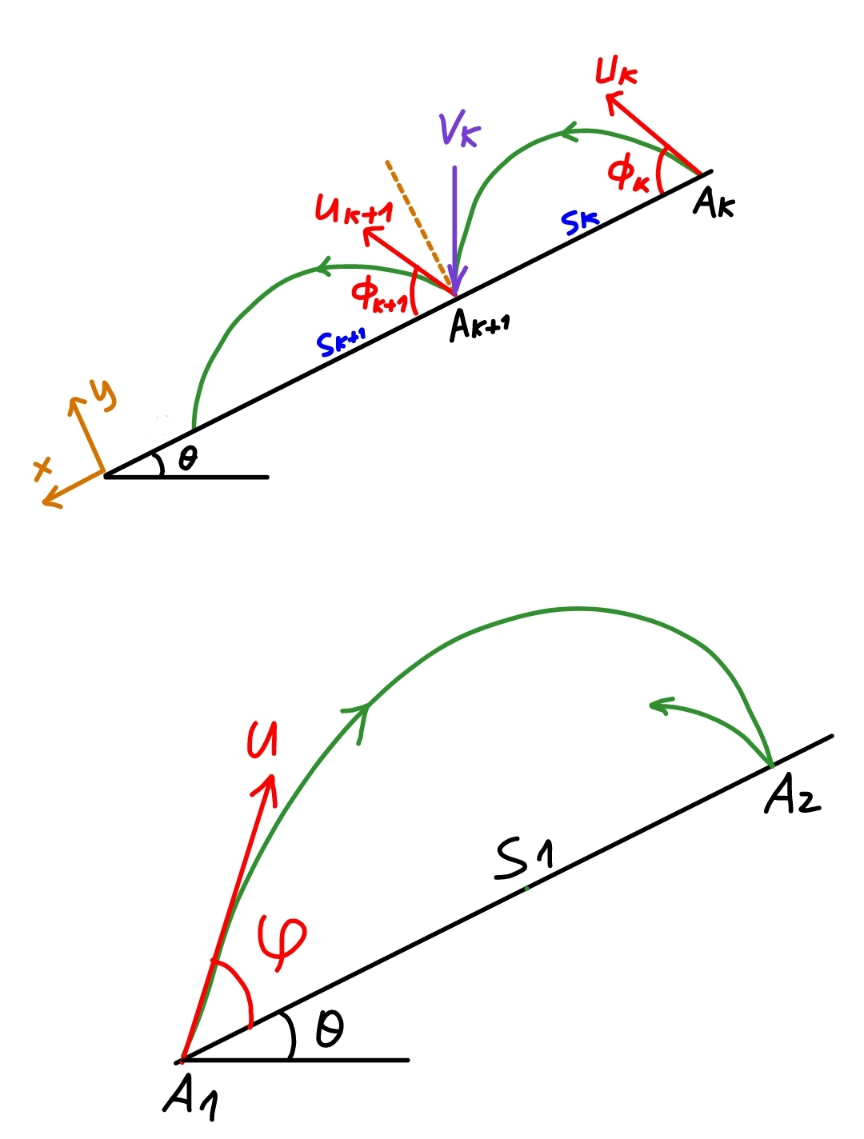Question Number 196493 by mr W last updated on 26/Aug/23

Commented by mr W last updated on 27/Aug/23

$${solution}\:{to}\:{question}\:#\mathrm{196172} \\ $$
Answered by mr W last updated on 29/Aug/23

$${U}_{{k}} \mathrm{sin}\:\phi_{{k}} {t}_{{k}} −\frac{{g}\:\mathrm{cos}\:\theta}{\mathrm{2}}{t}_{{k}} ^{\mathrm{2}} =\mathrm{0} \\ $$$$\Rightarrow{t}_{{k}} =\frac{\mathrm{2}{U}_{{k}} \:\mathrm{sin}\:\phi_{{k}} }{{g}\:\mathrm{cos}\:\theta} \\ $$$${s}_{{k}} ={U}_{{k}} \mathrm{cos}\:\phi_{{k}} {t}_{{k}} +\frac{{g}\:\mathrm{sin}\:\theta}{\mathrm{2}}{t}_{{k}} ^{\mathrm{2}} \\ $$$${s}_{{k}} ={U}_{{k}} \mathrm{cos}\:\phi_{{k}} ×\frac{\mathrm{2}{U}_{{k}} \:\mathrm{sin}\:\phi_{{k}} }{{g}\:\mathrm{cos}\:\theta}+\frac{{g}\:\mathrm{sin}\:\theta}{\mathrm{2}}×\left(\frac{\mathrm{2}{U}_{{k}} \:\mathrm{sin}\:\phi_{{k}} }{{g}\:\mathrm{cos}\:\theta}\right)^{\mathrm{2}} \\ $$$$\Rightarrow{s}_{{k}} =\frac{\mathrm{2}{U}_{{k}} ^{\mathrm{2}} }{{g}\:\mathrm{cos}\:\theta}×\frac{\frac{\mathrm{1}}{\mathrm{tan}\:\phi_{{k}} }+\mathrm{tan}\:\theta}{\mathrm{1}+\frac{\mathrm{1}}{\mathrm{tan}^{\mathrm{2}} \:\phi_{{k}} }} \\ $$$${V}_{{kx}} ={U}_{{k}} \mathrm{cos}\:\phi_{{k}} +{g}\:\mathrm{sin}\:\theta\:{t}_{{k}} \\ $$$${V}_{{kx}} ={U}_{{k}} \mathrm{cos}\:\phi_{{k}} +{g}\:\mathrm{sin}\:\theta×\frac{\mathrm{2}{U}_{{k}} \:\mathrm{sin}\:\phi_{{k}} }{{g}\:\mathrm{cos}\:\theta} \\ $$$$\Rightarrow{V}_{{kx}} ={U}_{{k}} \mathrm{sin}\:\phi_{{k}} \left(\frac{\mathrm{1}}{\mathrm{tan}\:\phi_{{k}} }+\mathrm{2}\:\mathrm{tan}\:\theta\right) \\ $$$${V}_{{ky}} ={U}_{{k}} \mathrm{sin}\:\phi_{{k}} −{g}\:\mathrm{cos}\:\theta×{t}_{{k}} \\ $$$${V}_{{ky}} ={U}_{{k}} \mathrm{sin}\:\phi_{{k}} −{g}\:\mathrm{cos}\:\theta×\frac{\mathrm{2}{U}_{{k}} \:\mathrm{sin}\:\phi_{{k}} }{{g}\:\mathrm{cos}\:\theta} \\ $$$$\Rightarrow{V}_{{ky}} =−{U}_{{k}} \mathrm{sin}\:\phi_{{k}} \\ $$$${U}_{{k}+\mathrm{1}} \mathrm{cos}\:\phi_{{k}+\mathrm{1}} ={V}_{{kx}} \\ $$$$\Rightarrow{U}_{{k}+\mathrm{1}} \mathrm{cos}\:\phi_{{k}+\mathrm{1}} ={U}_{{k}} \mathrm{sin}\:\phi_{{k}} \left(\frac{\mathrm{1}}{\mathrm{tan}\:\phi_{{k}} }+\mathrm{2}\:\mathrm{tan}\:\theta\right) \\ $$$${U}_{{k}+\mathrm{1}} \mathrm{sin}\:\phi_{{k}+\mathrm{1}} =−{eV}_{{ky}} \\ $$$$\Rightarrow{U}_{{k}+\mathrm{1}} \mathrm{sin}\:\phi_{{k}+\mathrm{1}} ={eU}_{{k}} \mathrm{sin}\:\phi_{{k}} \\ $$$$\Rightarrow\frac{\mathrm{1}}{\mathrm{tan}\:\phi_{{k}+\mathrm{1}} }=\frac{\mathrm{1}}{{e}}\left(\frac{\mathrm{1}}{\mathrm{tan}\:\phi_{{k}} }+\mathrm{2}\:\mathrm{tan}\:\theta\right) \\ $$$$\frac{{U}_{{k}+\mathrm{1}} }{{U}_{{k}} }=\frac{{e}\:\mathrm{sin}\:\phi_{{k}} }{\mathrm{sin}\:\phi_{{k}+\mathrm{1}} } \\ $$$$\frac{{U}_{{k}+\mathrm{1}} ^{\mathrm{2}} }{{U}_{{k}} ^{\mathrm{2}} }=\frac{{e}^{\mathrm{2}} \left(\mathrm{1}+\frac{\mathrm{1}}{\mathrm{tan}^{\mathrm{2}} \:\phi_{{k}+\mathrm{1}} }\right)}{\mathrm{1}+\frac{\mathrm{1}}{\mathrm{tan}^{\mathrm{2}} \:\phi_{{k}} }} \\ $$$$\Rightarrow\frac{{U}_{{k}+\mathrm{1}} ^{\mathrm{2}} }{{U}_{{k}} ^{\mathrm{2}} }=\frac{{e}^{\mathrm{2}} +\left(\frac{\mathrm{1}}{\mathrm{tan}\:\phi_{{k}} }+\mathrm{2}\:\mathrm{tan}\:\theta\right)^{\mathrm{2}} }{\mathrm{1}+\frac{\mathrm{1}}{\mathrm{tan}^{\mathrm{2}} \:\phi_{{k}} }} \\ $$$${let}\:\delta_{{k}} =\frac{\mathrm{1}}{\mathrm{tan}\:\phi_{{k}} } \\ $$$${s}_{{k}} =\frac{\mathrm{2}{U}_{{k}} ^{\mathrm{2}} }{{g}\:\mathrm{cos}\:\theta}×\frac{\delta_{{k}} +\mathrm{tan}\:\theta}{\mathrm{1}+\delta_{{k}} ^{\mathrm{2}} } \\ $$$${U}_{{k}+\mathrm{1}} ={U}_{{k}} \sqrt{\frac{{e}^{\mathrm{2}} +\left(\delta_{{k}} +\mathrm{2}\:\mathrm{tan}\:\theta\right)^{\mathrm{2}} }{\mathrm{1}+\delta_{{k}} ^{\mathrm{2}} }} \\ $$$$\delta_{{k}+\mathrm{1}} =\frac{\mathrm{1}}{{e}}\left(\delta_{{k}} +\mathrm{2}\:\mathrm{tan}\:\theta\right) \\ $$$${U}_{\mathrm{1}} ={u} \\ $$$$\phi_{\mathrm{1}} =\pi−\varphi \\ $$$$\delta_{\mathrm{1}} =\frac{\mathrm{1}}{\mathrm{tan}\:\phi_{\mathrm{1}} }=−\frac{\mathrm{1}}{\mathrm{tan}\:\varphi}=\lambda \\ $$$${such}\:{that}\:{the}\:{ball}\:{exactly}\:{returns}\:{to} \\ $$$${the}\:{start}\:{point}, \\ $$$${s}_{\mathrm{1}} +{s}_{\mathrm{2}} +{s}_{\mathrm{3}} +…+{s}_{{n}} =\mathrm{0} \\ $$$${from}\:{which}\:{we}\:{can}\:{get}\:\lambda,\:{thus}\:\phi_{\mathrm{1}} ,\phi_{\mathrm{2}} … \\ $$$${some}\:{examples}\:{for}\:{n}=\mathrm{3}\:{and}\:\mathrm{4}: \\ $$
Commented by mr W last updated on 27/Aug/23

Commented by mr W last updated on 26/Aug/23

Commented by mr W last updated on 26/Aug/23

Commented by mr W last updated on 26/Aug/23

Commented by mr W last updated on 27/Aug/23

Commented by mr W last updated on 28/Aug/23
![δ_(k+1) =(1/e)(δ_k +2 tan θ) say δ_(k+1) +A=(1/e)(δ_k +A) δ_(k+1) =(1/e)[δ_k +(1−e)A] (1−e)A=2 tan θ ⇒A=((2 tan θ)/(1−e)) δ_(k+1) +((2 tan θ)/(1−e))=(1/e)(δ_k +((2 tan θ)/(1−e))) ⇒δ_k +((2 tan θ)/(1−e))=(1/e^(k−1) )(δ_1 +((2 tan θ)/(1−e))) determinant ((((1/(tan φ_k ))=(1/e^(k−1) )(−(1/(tan ϕ))+((2 tan θ)/(1−e)))−((2 tan θ)/(1−e)))))](https://www.tinkutara.com/question/Q196609.png)
$$\delta_{{k}+\mathrm{1}} =\frac{\mathrm{1}}{{e}}\left(\delta_{{k}} +\mathrm{2}\:\mathrm{tan}\:\theta\right) \\ $$$${say}\:\delta_{{k}+\mathrm{1}} +{A}=\frac{\mathrm{1}}{{e}}\left(\delta_{{k}} +{A}\right) \\ $$$$\delta_{{k}+\mathrm{1}} =\frac{\mathrm{1}}{{e}}\left[\delta_{{k}} +\left(\mathrm{1}−{e}\right){A}\right] \\ $$$$\left(\mathrm{1}−{e}\right){A}=\mathrm{2}\:\mathrm{tan}\:\theta \\ $$$$\Rightarrow{A}=\frac{\mathrm{2}\:\mathrm{tan}\:\theta}{\mathrm{1}−{e}} \\ $$$$\delta_{{k}+\mathrm{1}} +\frac{\mathrm{2}\:\mathrm{tan}\:\theta}{\mathrm{1}−{e}}=\frac{\mathrm{1}}{{e}}\left(\delta_{{k}} +\frac{\mathrm{2}\:\mathrm{tan}\:\theta}{\mathrm{1}−{e}}\right) \\ $$$$\Rightarrow\delta_{{k}} +\frac{\mathrm{2}\:\mathrm{tan}\:\theta}{\mathrm{1}−{e}}=\frac{\mathrm{1}}{{e}^{{k}−\mathrm{1}} }\left(\delta_{\mathrm{1}} +\frac{\mathrm{2}\:\mathrm{tan}\:\theta}{\mathrm{1}−{e}}\right) \\ $$$$\begin{array}{|c|}{\frac{\mathrm{1}}{\mathrm{tan}\:\phi_{{k}} }=\frac{\mathrm{1}}{{e}^{{k}−\mathrm{1}} }\left(−\frac{\mathrm{1}}{\mathrm{tan}\:\varphi}+\frac{\mathrm{2}\:\mathrm{tan}\:\theta}{\mathrm{1}−{e}}\right)−\frac{\mathrm{2}\:\mathrm{tan}\:\theta}{\mathrm{1}−{e}}}\\\hline\end{array} \\ $$
